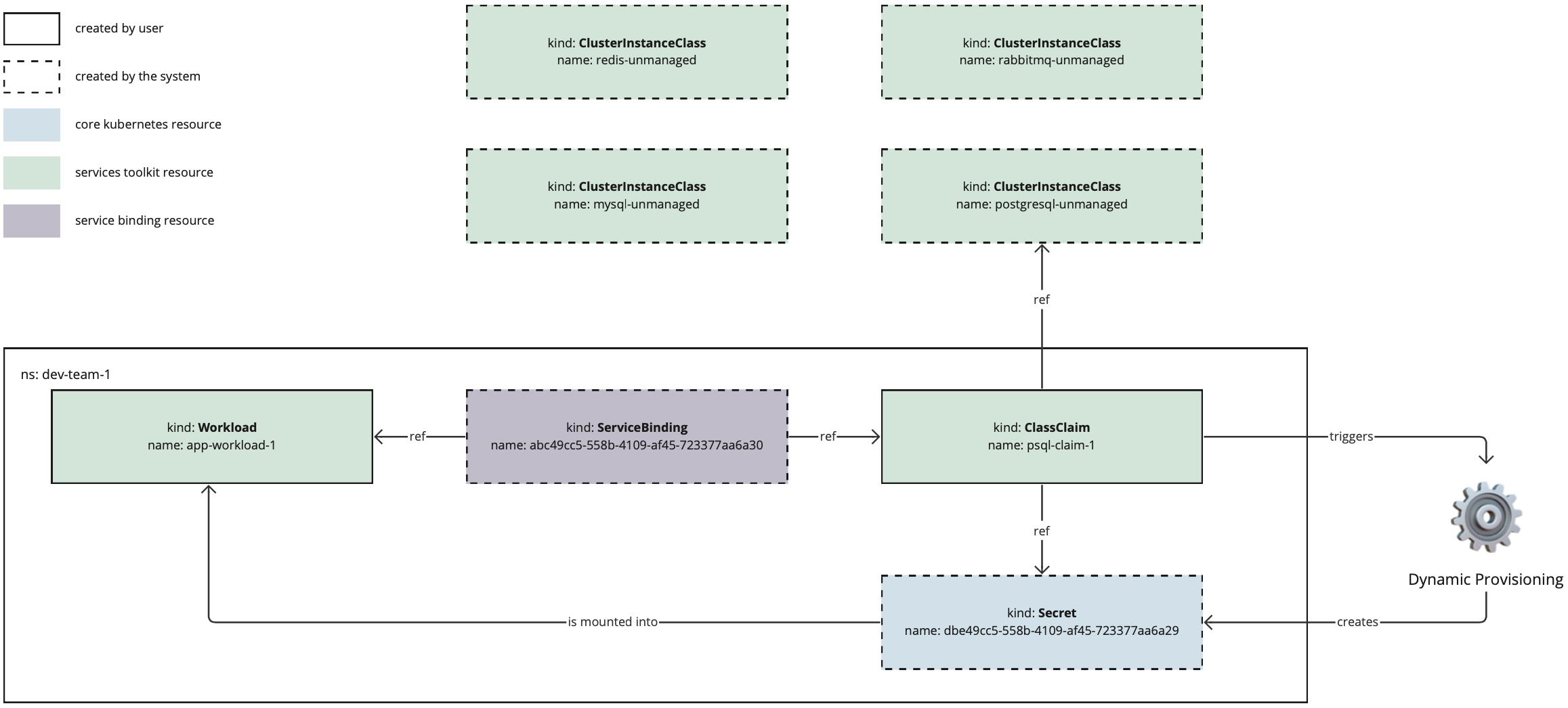Work with Bitnami Services
In this tutorial you learn how application operators can discover, claim, and bind services to application workloads.
Tanzu Application Platform has six services that are available in the Bitnami Services package. These are MySQL, PostgreSQL, RabbitMQ, Redis, MongoDB, and Kafka. The corresponding Bitnami Helm chart backs each of these services.
About this tutorial
Target user role: Application operator
Complexity: Basic
Estimated time: 15 minutes
Topics covered: Classes, claims, Bitnami
Learning outcomes: An understanding of how to work with the standard services provided by the Bitnami Services package
Prerequisites
To follow this tutorial, you must have:
- Access to a Tanzu Application Platform cluster v1.5.0 or later.
- Installed the Tanzu services CLI plug-in v0.6.0 or later.
Concepts
The following diagram provides an overview of the elements you will use during this tutorial and how these elements fit together.

In this diagram:
-
There are two elements that require user input. These are creating a
ClassClaimand creating aWorkload. The workload is configured to refer to the class claim. -
The life cycles of the
ClassClaimand theWorkloadare separate. This allows you to update one without affecting the other. -
The dynamic provisioning process is simplified. This is intentional because application operators and developers do not need to know about the inner workings and configuration of service instances.
Procedure
The following steps explain how to work with Bitnami Services.
Step 1: Discover the services
-
Application teams can discover the range of available services by running:
tanzu service class listExample output:
NAME DESCRIPTION kafka-unmanaged Kafka by Bitnami mongodb-unmanaged MongoDB by Bitnami mysql-unmanaged MySQL by Bitnami postgresql-unmanaged PostgreSQL by Bitnami rabbitmq-unmanaged RabbitMQ by Bitnami redis-unmanaged Redis by BitnamiThis output shows six classes. These are the six services available in the Bitnami Services package. You can see from the names and descriptions that they are all unmanaged services. This implies that the resulting service instances run on cluster, that is, they are not a managed service running in the cloud. Other classes might be listed here as well.
As an application operator, you review the classes on offer and choose one that meets your requirements.
-
You can learn more about a class by running:
tanzu service class get postgresql-unmanagedExample output:
NAME: postgresql-unmanaged DESCRIPTION: PostgreSQL by Bitnami READY: true PARAMETERS: KEY DESCRIPTION TYPE DEFAULT REQUIRED storageGB The desired storage capacity of the database, in Gigabytes. integer 1 falseThe output shows the name, a short description for the class, its current status, and the parameters. The parameters represent the set of configuration options that are available to application teams.
The
postgresql-unmanagedclass here has one parameter, which isstorageGB. You can also see that it is not required to pass this parameter when creating a claim for the class, in which case the default value of1is used.
Step 2: Claim a service
In this example you have an application workload that requires a PostgreSQL database to function correctly. You can claim the PostgreSQL Bitnami service to obtain such a database.
To claim a PostgreSQL service:
-
Create the namespace
dev-team-1by running:kubectl create namespace dev-team-1 -
Create a claim for the
postgresql-unmanagedclass.The following command also overrides the default value of
1for thestorageGBparameter by setting it to3. You can override any of the options.tanzu service class-claim create psql-1 \ --class postgresql-unmanaged \ --parameter storageGB=3 \ -n dev-team-1Example output:
Creating claim 'psql-1' in namespace 'dev-team-1'. Please run `tanzu service class-claim get psql-1 --namespace dev-team-1` to see the progress of create. -
Confirm the status of the claim by running:
tanzu service class-claim get psql-1 --namespace dev-team-1Example output:
Name: psql-1 Namespace: dev-team-1 Claim Reference: services.apps.tanzu.vmware.com/v1alpha1:ClassClaim:psql-1 Class Reference: Name: postgresql-unmanaged Parameters: storageGB: 3 Status: Ready: True Claimed Resource: Name: 7974379c-7b4d-41c3-af57-f4f1ae08c65d Namespace: dev-team-1 Group: Version: v1 Kind: SecretWait for the claim to report
Ready: True.
After the claim is ready, you then have a successful claim for a PostgreSQL database configured to your needs with 3 GB of storage.
Step 3: Bind the claim to a workload
After creating the service claim, you can bind it to one or more of your application workloads.
ImportantIf you are binding to more than one application workload, all application workloads must exist in the same namespace. This is a known limitation. For more information, see Cannot claim and bind to the same service instance from across multiple namespaces.
To bind the claim to your workload:
-
Find the reference for the claim by running:
tanzu service class-claim get psql-1The reference is in the output under the heading
Claim Reference. -
Bind the claim to your workload by passing the reference for the claim to the
--service-refflag of thetanzu apps workload createcommand. For example:tanzu apps workload create my-workload \ --image my-registry/my-app-image \ --service-ref db=services.apps.tanzu.vmware.com/v1alpha1:ClassClaim:psql-1You must pass the claim reference with a corresponding name that follows the format
--service-ref db=services.apps.tanzu.vmware.com/v1alpha1:ClassClaim:psql-1. Thedb=prefix to this example reference is an arbitrary name for the reference.